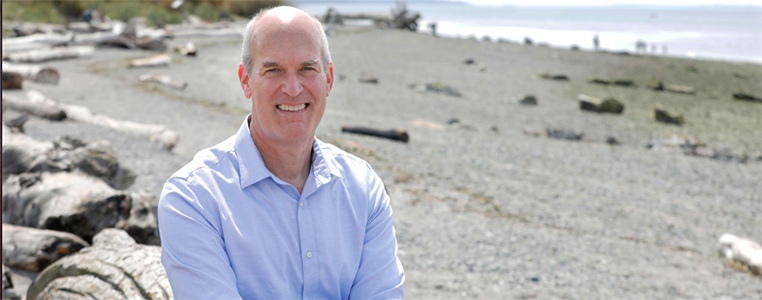— by Susan McBain, Orcas Issues reporter —
EDITOR’S NOTE: This post has been updated to reflect the October 1 meeting will be at Orcas Library.
Five senior leaders from UW Neighborhood Clinics (UWNC) and the UW Medicine Orcas clinic attended the September 17 meeting of the Orcas Island Health Care District (OIHCD) to present UWNC’s FY2019 Annual Report to the commissioners. Mark Bresnick, Associate Director of UWNC’s North Region, was the chief presenter; additional information was provided by Debra Gussin, UWNC Executive Director; Dr. Matt Jaffy, Associate Medical Director of the North Region; Dr. Mike Alperin, Orcas & Lopez Clinics Medical Director; and Jen Taylor, Orcas Clinic Manager. Most of the two-hour meeting was devoted to discussing the report and answering commissioners’ specific questions.
The report, covering the period July 1, 2018 to June 30, 2019, began with a financial update showing budgeted and actual revenues, expenses, number of visits, payer mix, and staffing. Discussions of quality metrics, patient experience, and staffing and operations followed. Some significant points:
- The percentage of patients on Orcas who are insured by Medicare and Medicaid is nearly 70%, compared with 57% on the mainland. Both programs generally reimburse less, sometimes much less, than commercial insurance or actual costs of care. (For this reason, the District is exploring possibilities for designation of the Orcas clinic as a Rural Health Clinic or Federally Qualified Health Center, which would likely increase reimbursements.)
- The Orcas clinic’s actual net loss for the year was $707,985, compared with a budgeted net loss of $539,101. Subsidies for the two major clinics—UWNC and Orcas Family Health Center (OFHC)—for their operating losses constitute the major part of the District’s annual budget.
- Regarding quality of care, standard measures of preventative care rose steadily throughout the year yet didn’t reach targets. Measures of disease management (diabetes, hypertension, depression) fluctuated, mainly because of staffing shortages, according to Bresnick.
- In a widely used survey of patient satisfaction, responses by Orcas patients during January–June 2019 were mostly positive on the 22 measures. Eighty percent or more of patients gave the highest rating on 15 measures, and 90% did so on 10 measures. The lowest ratings were for access to care (phone access during and after office hours, and waiting times).
- The clinic staff appears to be highly motivated and caring, but their services have been hampered by staff shortages, especially clinical support staff. Recent turnover in RNs and loss of the nurse practitioner (NP) have exacerbated the problem. The NP was not replaced, but both nurse positions are now filled, and UWNC would like to add another medical assistant as well.
- According to the report, the clinic offers 24/7 triage and on-call coverage. The report stated that in recent months 45% of after-hours callers were managed over the phone by nurse advice or on-call provider; 31% were evaluated and recommended to be seen in the clinic in the next 24-72 hours; 13% were seen same day in the clinic (including many evenings and weekends); and 11% were assessed to be emergent and directed to 911. A recent incident in which a weekend patient did not know how to contact a local physician highlighted the need for better communications, including signage at the clinic regarding access to after-hours care.
Commissioner Patty Miller continued to be concerned that UWNC’s daily visits per provider remain fewer than OFHC’s, yet reported levels of stress for UWNC staff are higher. She would like to explore the reasons why.
In other business, the commissioners reviewed OFHC’s proposed budget for FY2020, which begins October 1. Because OFHC is unable to offer the range of employee benefits available to UWNC providers and staff, commissioners felt that paying the premium for basic health, vision, and dental insurance for employees was appropriate. They voted to pay the full premium cost for employees working half time or more, and 80% of the premium for employees working less than half time.
Planning continued for the District’s two Town Hall meetings. The first is scheduled for Saturday, October 5, 3–5 p.m. at the Eastsound Fire Hall; the second will be held Monday, October 28, 5:30–7:30 p.m. in the Madrona Room at Orcas Center. The first meeting will begin with a presentation of about 20 minutes on District accomplishments, issues, and next steps; the rest of the time will be devoted to Q&A and feedback. The second meeting will incorporate results from the first.
The next District regular meeting has been rescheduled from Tuesday, October 1, to Wednesday, October 2, 5:30–7:30 p.m., at the Orcas Island Library.
For readers interested in more detail about meetings, minutes of each meeting are available on the District website. Minutes of a meeting are generally posted following the next meeting after approval by the commissioners.
**If you are reading theOrcasonian for free, thank your fellow islanders. If you would like to support theOrcasonian CLICK HERE to set your modestly-priced, voluntary subscription. Otherwise, no worries; we’re happy to share with you.**









News Flash:
the first Town Hall meeting is cancelled due to conflict with the memorial service for John, so we have extra time to prepare our thoughts for the next scheduled one, Monday October 28.
The new consultant’s report will be available and thus the conversation should be much more substantial as to future strategic structural changes. Bring enough good questions and we may have material for a second THM. ..or it may be clear! The rationale being followed is transparent, but it does take some work.. Looking forward to it.